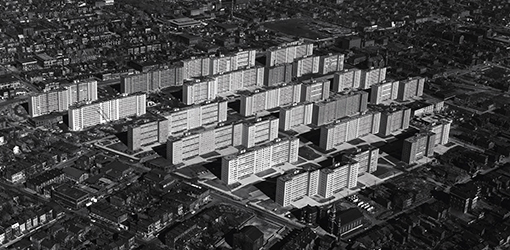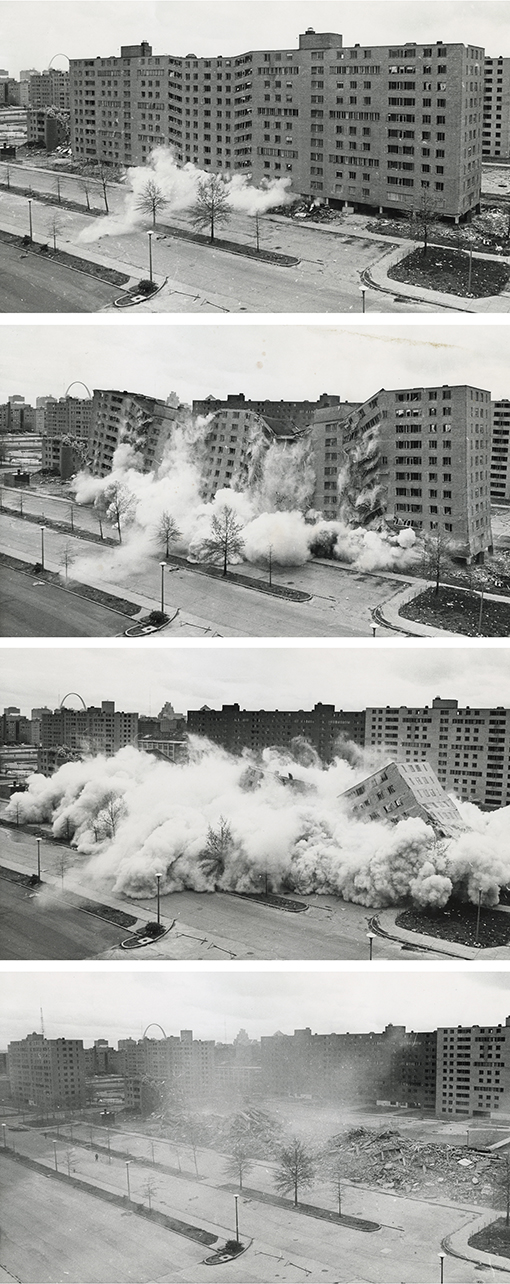Pruitt-Igoe: Asking the Wrong Questions
Posted on December 12, 2012 | posted by:September 1945: another war was over, and St.Louis, a city like many others across the country, counted the costs. As life struggled to return to normal, it became obvious how profoundly the city had been battered by the depression of the war years. In the aftermath, she showed the signs of strain and of neglect. The scars of deprivation had left the city exhausted—she had been drained of her beauty and vitality. Structural and foundational buildings, had unravelled, as paint peeled away and concrete began to crumble.
As the city called out in distress, the government and the policy makers scrambled to find solutions. Beneath the bleak surface of despair was an opportunity to reconstruct, and to revitalize the vibrancy that had once thrived. Out of this reactionary time emerged the United States Housing Act of 1949, a landmark in mortgage insurance and the construction of public housing, which officials felt would act as a turning point in the downfall of cities. By demolishing the rubble, and replacing this land with modern high-rise units, they felt they would create a turning point for their communities and make room for urban renewal.
So there, at the heart of the war-ravaged city of St.Louis in 1954, stood the future. Out of the dust of the slums rose 33 identical beacons of hope, otherwise known as Pruitt-Igoe. The walls of the buildings towered eleven stories into the sky, far above the reaches of the other structures in the core. The 2,780 apartments offered hope and refuge. The city’s utopia stood squarely before them like an oasis in a desert. Or at least, that’s what the architects had thought.
The urine-stained skip-stop elevators that soared to only every 3rd ‘gallery’ floor, became breeding grounds for theft and for muggings. The open spaces that were intended to act as individual communities, became gang war zones and territorial domains. The residents led in flocks. Occupancy rate had been on a steady decline for the last decade.Ultimately, the promises of the innovations of the Pruitt-Igoe buildings slowly began to crumble. What was supposed to be disappeared into the dust. But what went wrong?
Frankly, it really depends on who you talk to. Architects blame modernism, and modernist architects blame the government. It’s a never ending debate about the ‘myth’ of Pruitt-Igoe.
But, let’s be honest, the easiest part of failure is being able to point your finger at the other person. The Pruitt-Igoe debate is a very good example of this. We keep disputing whether the architecture, the social problems or the policy is to blame for the downfall of these complexes. Frankly, we are asking the wrong questions. From my standpoint, the problem was the solution itself. This really is a matter of the ‘Top-Down Pruitt-Igoe’ myth and nothing else.
Pruitt-Igoe was a vision of government leaders—it was their solution to address the problems of the poor. Once the reconstruction decision was made, bulldozers came into the downtown core and destroyed roughly 20 blocks of ‘slums’ and displaced vast communities of people. This was a growing trend across the city of St.Louis: the ‘slums’ for the low-income population to reside in were disappearing. Once the 33 buildings of Pruitt-Igoe were erected, there was virtually nowhere else for these people to live. Families had no choice but to move into social housing units from the neighbourhoods they once occupied. As the tenancy leader of Pruitt-Igoe once said, “We are no longer human beings. We are Pruitt-Igoe”.
Government neglected to consider many factors when designing their solution to post-war St.Louis. For one, the redevelopment did not consider the dynamics of the community that was actually going to live within the walls of the complexes. As a matter of fact, they designed communal spaces for these structures, fully expecting that the residents would adapt to the ‘sense of community’ that was designed. In actuality, the residents of these ‘slums’ measured the richness of their neighborhoods not by money, but by a sense of community that was different from the architects and urban planners. These people lived by a unique set of values—a fact which the government officials overlooked and, as a result, did not factor into their plans. Ultimately, the redevelopment plan ignored the histories and realities of these people.
Another fallacy of policy making is evident in Pruitt-Igoe. The government and other key stakeholders incorrectly assumed that the circumstances they observed at an exact moment would only change if policy makers took immediate action. The reality is, however, that the conditions at any given moment are merely a snapshot of a bigger picture and a bigger system. In other words, they don’t tell the full story. Because government limited its thinking and attention to addressing the tensions witnessed at that pinnacle moment in history, the future of the Pruitt-Igoe complexes was pre-ordained. They didn’t consider the mass exodus of the middle-class, or the gradual decline of the poor into different financial and social tiers.
The main value and motivation in the creation of these plans was money. What if the project was premised on a different set of values? Say, cultural? Political? Entrepreneurial? Sustainable? Would the government’s plan for revitalization have looked differently if this were the case?
This line of questioning leads to a larger design narrative. How can we start to encourage our collaborators to ask the right questions when failures arise? How can we start to challenge our own solutions, regardless of our attachment to them? Why isn’t it okay to sometimes be wrong?
We, designers and professionals, need to be more reflexive not just in our processes, but in our failures.

